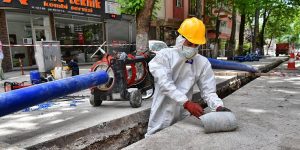Types of Asbestos Found in Sydney Households

A trained professional in protective gear, engrossed in the detailed examination of a piece of asbestos.
Types of Asbestos Found in Sydney Households
Living in New South Wales (NSW), Australia, asbestos is a term you might have encountered, especially if your home was built before 2003This is A comprehensive guide explore the different types of asbestos commonly found in Sydney households and why understanding them is crucial for your health and safety.
What is Asbestos?
Asbestos refers to six naturally occurring minerals. These minerals are fine, durable fibres resistant to heat, electricity, and corrosion. Due to these properties, asbestos was widely used in construction materials until its ban in Australia in 2003 after its detrimental health effects were discovered.
The Prevalence of Asbestos in NSW, Australia
In NSW, particularly in Sydney, many houses built before 2003 contain asbestos. Materials like roof shingles, insulation, floor tiles, cement, and paint often included asbestos. These materials pose no harm if left undisturbed. However, if damaged, they can release asbestos fibres into the air, posing potential health hazards upon inhalation.
The Health Impact: Diseases Associated with Asbestos
Asbestos exposure can lead to severe health conditions, especially after long-term exposure. These include Asbestosis, a lung disease causing scarring of lung tissue, Lung Cancer, and Mesothelioma, a rare cancer affecting the lining of the lungs and abdomen.
Unmasking the Culprit: Types of Asbestos and Where They Are Found
Understanding the types of asbestos and their common places in homes is vital to prevention. The most commonly found types in Sydney homes are:
Chrysotile (White Asbestos)
They were used extensively in roofs, ceilings, walls, and floors due to their excellent insulation properties.
Amosite (Brown Asbestos)
Primarily used in cement sheets, pipe insulation, and ceiling tiles.
Crocidolite (Blue Asbestos)
It is considered the most dangerous type in spray-on coatings, pipe insulation, and cement products.
Less common types include:
Anthophyllite
This type was occasionally used in construction materials and insulation products.
Tremolite and Actinolite
While not commercially used, they can be found as contaminants in chrysotile asbestos and vermiculite insulation.
The Safe Route: How Do You Remove Asbestos?
If you suspect the presence of asbestos in your home, remember asbestos removal isn’t a DIY task. Disturbing the material can release harmful fibres into the air.
Asbestos Testing
Doubts should lead to asbestos testing. Professionals can take a sample safely and send it to a lab for analysis.
Professional Asbestos Removal
If asbestos is confirmed, the next step is professional asbestos removal. Experts with the necessary training and equipment can safely remove and dispose of asbestos materials.
Disposing of the Threat: Asbestos Disposal by Professionals
Asbestos disposal by professionals is vital to avoid further contamination. Asbestos waste is sealed, labelled, and transported to a designated landfill site.
Preventive Measures: Prevention and Safety Measures
Be cautious of potential asbestos-containing materials if your home was built before 2003. Avoid actions that might disturb these materials, and seek professional help if you notice signs of wear or damage.
The Need for Professional Services
When dealing with asbestos, it’s essential to reiterate the importance of professional services. Asbestos professionals have the knowledge, tools, and protective gear to safely handle asbestos. They adhere to strict guidelines to prevent the spread of asbestos fibres during testing, removal, and disposal.
Remember, disturbing asbestos in your home can release hazardous fibres into the air. This is something you want to avoid. Instead, hire trained professionals to navigate these dangers and ensure your home is safe and asbestos-free.
Conclusion
While banned since 2003, asbestos still lurks in many Sydney households built before the ban. Given its potential health risks, it’s crucial to be aware of the types of asbestos that might be present in your home and the places they are commonly found. But remember, if you suspect the presence of asbestos, never attempt to handle it yourself. Always seek help from professional asbestos testing and removal services.
While banned, asbestos is still present in many Sydney households. Given its health risks, it’s critical to understand the types of asbestos and where they might be in your home. If you suspect asbestos, never attempt to handle it yourself. Always seek professional asbestos testing and removal services.
Here at Rapid Demolition, we specialise in asbestos removal, providing you with the peace of mind you deserve. If you believe asbestos is present in your home, contact us immediately. We’re equipped with the right tools, training, and protocols to ensure your home is free from this hazardous material.
Understanding asbestos and its dangers are the first step towards a safer home. Trust in us, Rapid Demolition, to take those next critical steps. Stay aware, stay informed, and most importantly, stay safe.
